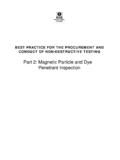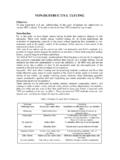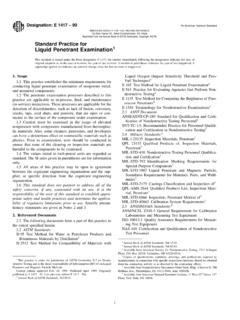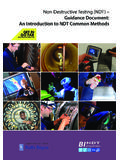Transcription of Chapter Weld Inspection and Repair - Goodheart …
1 ObjectivesAfter completing this Chapter , you will be able to: Identify areas that should be inspected by a GTAW welder. Recall the various types of nondestructive tests and their advantages and disadvantages. Recall the various types of destructive tests. Recall the tests used in weld integrity inspections. Identify the conditions that require dimensional repairs and the techniques used to make these repairs. Identify various types of surface defects and explain corrective actions for each type. Recall procedures for finding and repairing internal defects.
2 Recall the preparation needed prior to making repairs. Summarize proper welding practices for repairs. Explain the need for postweld Inspection and Repair Termsbend testscorrosion testscross section testsdefectdestructive testsdiscontinuitydye penetrant testferrite testflawfluorescent penetrant testgamma rayshardness testshydrostatic testimage quality indicator (IQI)macrotestmagnetic particle test (MT)microhardness testmicrotestnick-break testsnondestructive examination (NDE)notch-toughness testspenetrameterspenetrant test (PT)pressure testsquality controlradiographic test (RT)temper beadstensile testsultrasonic testing (UT)visual test (VT)
3 X-raysIntroductionQuality control is used throughout the welding industry to monitor the quality of the items produced. All manufactured items are made to specifications. Inspections must be made during and after the manufac-turing cycle to ensure that parts meet the requirements of the specifications. The American Welding Society has increased the requirements for a CWI (certified welding inspector) certificate to ensure that certificate recipients are capable of performing quality control. Quality control is not only important to ensure quality parts but also to ensure that the correct procedures are performed as efficiently as possible.
4 The use of proper quality control measures help make a company as strong as possible in an increasingly competitive industry. 265 ChapterWeld Inspection and RepairThis sample Chapter is for review purposes only. Copyright The Goodheart -Willcox Co., Inc. All rights Gas Tungsten Arc Welding HandbookInspection AreasGTAW welders need to ensure that all aspects of the operation are performed correctly. At a minimum, welders should check the following areas: Base material is as specified. Joint design is as specified and within required tolerances. Filler metal type and size are correct.
5 Required welding equipment is available and operating satisfactorily. Tooling has been adequately tested to determine that it will properly support the operation. Parts have been properly cleaned. Welder training or certification is sufficient for the weld operation. Proper welding procedure is used and the welding equipment is set up properly for the operation. Inspections and tests required during the welding operation are performed as specified. Completed weld has been inspected to ensure that it will meet the visual requirements. Additional nondestructive examination is usually performed by other of InspectionInspections are performed to determine whether a weld meets expectations.
6 Depending on the final use of the weldment, several types of inspections may be required, ranging from simple visual Inspection to rigorous Examination (NDE)Inspections and tests of a weld that do not destroy any portion of the completed weld are called nondestructive examination (NDE). Inspections and tests that destroy the completed weld , or samples of the completed weld , are called destructive TestA visual test (VT) is one of the most important methods of Inspection and is widely used for accep-tance of welds. VT is also used to identify bad welds before other more expensive or time-consuming forms of Inspection are performed.
7 Visual Inspection is easy to apply, quick, and relatively inexpensive. Visual testing equipment includes rulers, fillet weld gauges, squares, magnifying glasses, and reference weld samples. Some of the various tools used in weld Inspection are shown in Figures 18-1, 18-2, and 18-3. These tools include the following:Bridge camgaugeAutomaticweld size gaugeV-WACgaugeFilletweldgaugesExtension mirrorsOptical comparatorw/ scaleMagnificationlensesFigure 18-1. An Inspection kit may include any of the tools shown here. These tools are used to inspect a variety of dimensions, including material thickness, bevel angle, crown height, undercut, mismatch, fillet weld leg length, and throat thickness.
8 (Mark Prosser) Chapter 18 weld Inspection and Repair 267 Optical Comparator. Magnifies, illuminates, and precisely measures weld discontinuities. Magnification lenses. Pocket-sized magnification lenses. Extension mirrors. Used for root pass Inspection of pipe welds Fillet weld gauge. Measures the size of fillet welds. V-WAC gauge. Used for measuring height and depth. The gauge checks undercut depth, porosity comparison, amount of porosity per linear inch and crown height. Automatic weld size gauge. Measures several aspects of a weld , including the height. Bridge cam gauge.
9 Used for measuring several aspects of welds, such as depth of undercut, depth of pitting, and fillet weld throat size and leg tests provide very important informa-tion about a weld s general conformity to specifica-tions. The following weld features are measured and compared to specifications to ensure that the weld meets expectations: crown height crown profile weld size weld length dimensional variation root side profile root side penetration surface color (titanium welds)In addition, a visual test may reveal discontinui-ties in the weld .
10 A discontinuity is any disruption in the consistency of a weld . A flaw in the weld is a discontinuity that is small enough that it does not render the weld unacceptable. A defect is a disconti-nuity that is serious enough to make the weld unac-ceptable. The following common problems can be detected by visual tests: underfill undercut overlap surface cracks crater cracks surface porosity joint mismatch warpagePenetrant TestA penetrant test (PT) is a sensitive method of detecting and locating minute discontinuities that are open to the surface of the weld .







